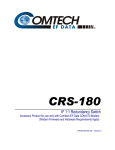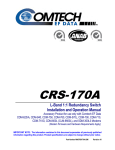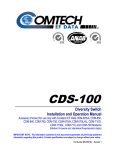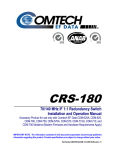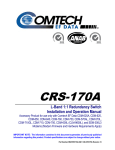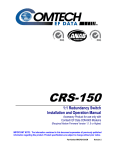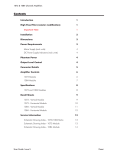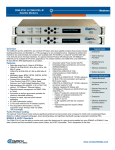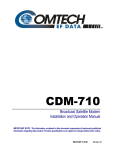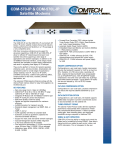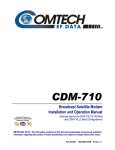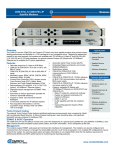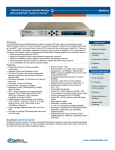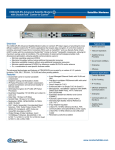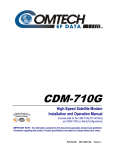Download CRS-180 - Satellite Bandwidth by New Era Systems
Transcript
CRS-180 70/140 MHz 1:1 Redundancy Switch Installation and Operation Manual Accessory Product for use only with Comtech EF Data CDM-625, CDM-570, CDM-700, and CDM-710 Modems (Modem Firmware and Hardware Requirements Apply) IMPORTANT NOTE: The information contained in this document supersedes all previously published information regarding this product. Product specifications are subject to change without prior notice. Part Number MN/CRS180.IOM Revision 3 CRS-180 70/140 MHz 1:1 Redundancy Switch Installation and Operation Manual Accessory Product for use only with Comtech EF Data CDM-625, CDM-570, CDM-700, and CDM-710 Modems (Modem Firmware and Hardware Requirements Apply) Part Number MN/CRS180.IOM Revision 3 June 23, 2008 Copyright © Comtech EF Data, 2008. All rights reserved. Printed in the USA. Comtech EF Data, 2114 West 7th Street, Tempe, Arizona 85281 USA, 480.333.2200, FAX: 480.333.2161 This page is intentionally blank. Table of Contents TABLE OF CONTENTS................................................................................................. III TABLES ......................................................................................................................... VI FIGURES ....................................................................................................................... VI PREFACE ......................................................................................................................IX Customer Support ........................................................................................................................ ix About this Manual ........................................................................................................................ x Reporting Comments or Suggestions Concerning this Manual .................................................. x Related Documents ....................................................................................................................... x Conventions and References ........................................................................................................ x Cautions and Warnings ............................................................................................................... x Metric Conversion ...................................................................................................................... x Recommended Standard Designations ...................................................................................... xi Trademarks ................................................................................................................................ xi EMC Compliance ......................................................................................................................... xi EN55022 Compliance................................................................................................................... xi EN50082-1 Compliance ............................................................................................................... xi Federal Communications Commission (FCC) .......................................................................... xi Safety Compliance ...................................................................................................................... xii EN 60950 .................................................................................................................................. xii Equipment Connection.............................................................................................................. xii Environmental ............................................................................................................................. xii Telecommunications Terminal Equipment Directive............................................................. xiii Low Voltage Directive (LVD) ................................................................................................... xiii iii CRS-180 70/140 MHz IF 1:1 Redundancy Switch Table of Contents Revision 3 MN/CRS180.IOM Warranty Policy ......................................................................................................................... xiii Limitations of Warranty ........................................................................................................... xiv Exclusive Remedies ................................................................................................................. xiv CHAPTER 1. INTRODUCTION ................................................................................ 1–1 1.1 Overview ........................................................................................................................ 1–1 1.1.1 Modem Side Connectors ............................................................................................. 1–2 1.1.2 Antenna Side Connectors ............................................................................................ 1–3 1.2 Functional Description ................................................................................................. 1–3 1.2.1 Operation with CDM-625, CDM-570L, CDM-700 and CDM-710 ........................... 1–3 1.2.1.1 IP Data 1:1 Switching Functional Description ................................................... 1–5 1.3 Summary of Specifications ........................................................................................... 1–7 CHAPTER 2. INSTALLATION ................................................................................. 2–1 2.1 Unpacking ...................................................................................................................... 2–1 2.2 Mounting........................................................................................................................ 2–2 CHAPTER 3. MODEM AND SWITCH CONFIGURATION ...................................... 3–1 3.1 Overview ........................................................................................................................ 3–1 3.2 Configuring CDM-625s for 1:1 Redundancy ............................................................. 3–2 3.2.1 IP Redundancy Configuration..................................................................................... 3–2 3.2.2 Carrier-in-Carrier® Redundancy Configuration .......................................................... 3–2 3.3 Configuring CDM-570s for 1:1 Redundancy ............................................................. 3–3 3.3.1 IP Redundancy Configuration..................................................................................... 3–4 3.3.2 Non-IP Redundancy Configuration ............................................................................ 3–5 3.4 Configuring CDM-7x0s for 1:1 Redundancy ............................................................. 3–6 3.4.1 IP Redundancy Configuration..................................................................................... 3–6 3.4.2 Non-IP Redundancy Configuration ............................................................................ 3–7 3.5 CRS-180 Switch DIP Settings ...................................................................................... 3–8 CHAPTER 4. CABLES AND CONNECTIONS ........................................................ 4–1 4.1 Overview ........................................................................................................................ 4–1 4.2 Cabling to the CDM-625 .............................................................................................. 4–1 4.2.1 CRS-180 Æ CDM-625 1:1 Redundancy Kit KT-0000045 ........................................ 4–2 iv CRS-180 70/140 MHz IF 1:1 Redundancy Switch Table of Contents Revision 3 MN/CRS180.IOM 4.2.2 Basic Modem-to-Switch Connection .......................................................................... 4–2 4.2.3 Data Interface Connection .......................................................................................... 4–4 4.2.3.1 RS-422/232 Interface Example ........................................................................... 4–5 4.2.3.2 HSSI Interface Example ..................................................................................... 4–5 4.2.3.3 ASI Interface Example ........................................................................................ 4–6 4.2.3.4 Quad E1 Interface Example ................................................................................ 4–6 4.2.3.5 G.703 Balanced Interface Example .................................................................... 4–7 4.2.3.6 G.703 Unbalanced Interface Example ................................................................ 4–7 4.2.3.7 Overhead Interface Example............................................................................... 4–8 4.2.3.8 Engineering Service Channel (ESC) Interface Example .................................... 4–8 4.2.3.9 10/100 Ethernet Interface Example .................................................................... 4–9 4.2.3.10 PMSI Interface Example ............................................................................... 4–10 4.3 Cabling to the CDM-570 ............................................................................................ 4–11 4.3.1 CRS-180 Æ CDM-570 1:1 Redundancy Kit KT/11559 ........................................... 4–11 4.3.2 Basic Modem-to-Switch Connection ........................................................................ 4–11 4.3.3 Data Interface Connection ........................................................................................ 4–13 4.3.3.1 RS-422/232 Interface Example ......................................................................... 4–13 4.3.3.2 G.703 Balanced Interface Example .................................................................. 4–14 4.3.3.3 G.703 Unbalanced Interface Example .............................................................. 4–14 4.3.3.4 10/100 Ethernet Interface Example .................................................................. 4–15 4.4 Cabling to the CDM-700 ............................................................................................ 4–17 4.4.1 Basic Modem-to-Switch Connection ........................................................................ 4–17 4.4.2 Data Interface Kits and Examples............................................................................. 4–19 4.4.2.1 KT/12542 G.703 E3/T3/STS-1 (CDI-10) 75Ω and KT/12578 HSSI (CDI-60) Cable Kit 4–20 4.4.2.2 KT/12579 155MB Copper (CDI-50) Cable Kit ................................................ 4–21 4.4.2.3 OC-3 (CDI-50) Cable Kits: KT/12580 (Single-Mode) or KT/12581 (Multi-Mode)......... 4–22 4.4.2.4 Gigabit Ethernet (GigE) (CDI-70) Interface ..................................................... 4–23 4.5 Cabling to the CDM-710 ............................................................................................ 4–24 4.5.1 Basic Modem-to-Switch Connection ........................................................................ 4–24 4.5.2 Data Interface Kits and Examples............................................................................. 4–26 4.5.2.1 KT/12579 ASI (CDI-40) 75Ω Cable Kit .......................................................... 4–27 4.5.2.2 KT/12578 HSSI (CDI-60) Interface Kit ........................................................... 4–28 4.5.2.3 Gigabit Ethernet (GigE) (CDI-70) Interface ..................................................... 4–29 CHAPTER 5. CONNECTOR PINOUTS ................................................................... 5–1 5.1 Overview ........................................................................................................................ 5–1 5.2 Modem Side: Type ‘BNC’ Connectors ....................................................................... 5–2 5.3 J3 Control Connector (Top) – Modem ‘A’ ................................................................. 5–2 v CRS-180 70/140 MHz IF 1:1 Redundancy Switch Table of Contents Revision 3 MN/CRS180.IOM 5.4 J4 Control Connector (Bottom) – Modem ‘B’ ........................................................... 5–3 5.5 Antenna Side: Type ‘BNC’ Connectors, J7 (Rx) and J8 (Tx)................................... 5–3 APPENDIX A. CABLE DRAWINGS ......................................................................... A-1 A.1 Introduction ................................................................................................................... A-1 A.1.1 Modem to CRS-180 Universal Control Cable, DB-9M to DB-9M ........................ A-2 A.1.2 Modem to User Data Cable, 1:1 ‘Y’ Splitter, (2X) DB-25M to DB-25F ............... A-3 A.1.3 Modem to User G.703 Balanced 1:1 ‘Y’ Splitter ................................................... A-4 A.1.4 Modem to CRS-180 Cable, Control Adapter (RoHS), DB-9M to DB-15F............ A-5 A.1.5 Modem to CRS-180 / Modem to User Control Adapter ‘Y’ Splitter, DB-15F to (2X) DB-9M (Optional) .................................................................................................................. A-6 A.1.6 Modem to User, CDM-625 Data Cable, (2X) DB-9M Æ DB-9F .......................... A-7 A.1.7 Modem to User, CDM-625 Quad E1 Adapter Cable, (2X) DB-15F Æ DB-9M .... A-8 A.1.8 Modem to User, CDM-625 Quad E1 Adapter Cable, (2X) RJ-48F to DB-9M ...... A-9 Tables Table 1-1. CRS-180 Application Summary ................................................................................ 1–2 Table 3-1. CRS-180 DIP Switch Settings ................................................................................... 3–8 Table 5-1. Modem Side Type ‘N’ Connectors........................................................................... 5–2 Table 5-2. J3 - Modem ‘A’ Control Connector Pin Assignments .............................................. 5–2 Table 5-3. J4 - Modem ‘B’ Control Connector Pin Assignments............................................... 5–3 Table 5-4. J7 (Rx) and J8 (Tx) Type ‘N’ Connectors ................................................................. 5–3 Table A-1. CRS-180 Cables ....................................................................................................... A-1 Figures Figure 1-1. CRS-180 70/140 MHz IF 1:1 Redundancy Switch .................................................. 1–1 Figure 1-2. CRS-180 – Modem Side Connectors ....................................................................... 1–2 Figure 1-3. CRS-180 – Antenna Side Connectors and Ground Lug........................................... 1–3 Figure 1-4. IP 1:1 Redundancy ................................................................................................... 1–5 Figure 1-5. 1:1 Redundancy Switchover .................................................................................... 1–6 Figure 2-1. KT/11708 Rack Mounting Kit (for horizontal or vertical mounting) ...................... 2–2 Figure 3-1. CDM-570 Configuration Interfaces ......................................................................... 3–3 Figure 3-2. CLI 1:1 Redundancy Configuration screen.............................................................. 3–5 Figure 3-3. CRS-180 Antenna Side – DIP Switches .................................................................. 3–8 vi CRS-180 70/140 MHz IF 1:1 Redundancy Switch Table of Contents Revision 3 MN/CRS180.IOM Figure 4-1. CDM-625 Basic Modem-to-Switch Connection ...................................................... 4–3 Figure 4-2. CDM-625 Block Diagram: User Æ Modem Æ Switch Æ Traffic .......................... 4–4 Figure 4-3. CDM-625 RS-422/232 1:1 Example ........................................................................ 4–5 Figure 4-4. CDM-625 HSSI 1:1 Example .................................................................................. 4–5 Figure 4-5. CDM-625 ASI 1:1 Example..................................................................................... 4–6 Figure 4-6. CDM-625 Quad E1 1:1 Example ............................................................................. 4–6 Figure 4-7. CDM-625 G.703 Balanced 1:1 Example ................................................................. 4–7 Figure 4-8. CDM-625 G.703 Unbalanced 1:1 Example ............................................................. 4–7 Figure 4-9. CDM-625 Overhead 1:1 Example ........................................................................... 4–8 Figure 4-10. CDM-625 ESC 1:1 Example .................................................................................. 4–8 Figure 4-11. CDM-625 10/100 Ethernet 1:1 Example ............................................................... 4–9 Figure 4-12. CDM-625 PMSI 1:1 Example .............................................................................. 4–10 Figure 4-13. CDM-570 Basic Modem-to-Switch Connection .................................................. 4–12 Figure 4-14. CDM-570 Block Diagram: User Æ Modem Æ Switch Æ Traffic ...................... 4–13 Figure 4-15. CDM-570 RS-422/232 1:1 Example .................................................................... 4–13 Figure 4-16. CDM-570 G.703 Balanced 1:1 Example ............................................................. 4–14 Figure 4-17. CDM-570 G.703 Unbalanced 1:1 Example ......................................................... 4–14 Figure 4-18. CDM-570 10/100 Ethernet 1:1 Example ............................................................. 4–15 Figure 4-19. CDM-700 Basic Modem-to-Switch Connection ................................................. 4–18 Figure 4-20. CDM-700 Block Diagram: User Æ Modem Æ Switch Æ Traffic ...................... 4–19 Figure 4-21. CDM-700 G.703 1:1 Example ............................................................................. 4–20 Figure 4-22. CDM-700 155MB Copper 1:1 Example .............................................................. 4–21 Figure 4-23. CDM-700 OC3 1:1 Example (Single-Mode shown) ........................................... 4–22 Figure 4-24. CDM-700 Gigabit Ethernet (GigE) 1:1 Example ................................................ 4–23 Figure 4-25. CDM-710 Basic Modem-to-Switch Connection ................................................. 4–25 Figure 4-26. CDM-710 Block Diagram: User Æ Modem Æ Switch Æ Traffic ...................... 4–26 Figure 4-27. CDM-710 ASI 1:1 Example................................................................................. 4–27 Figure 4-28. CDM-710 HSSI 1:1 Example .............................................................................. 4–28 Figure 4-29. CDM-710 Gigabit Ethernet (GigE) 1:1 Example ................................................ 4–29 Figure 5-1. CRS-180 – Modem and Antenna Side Connectors .................................................. 5–1 Figure A-1. Universal Control Cable (CA/WR9378-4) .............................................................. A-2 Figure A-2. 1:1 ‘Y’ Splitter Data Cable (Ref. CEFD Part No. CA/RB10461-1) ....................... A-3 Figure A-3. G.703 Balanced 1:1 ‘Y’ Splitter (Ref. CEFD Part No. CA/WR10522-1) .............. A-4 Figure A-4. Control Adapter Cable (Ref. CEFD Part No. CA/WR12135-1) ............................. A-5 Figure A-5. Optional Control Adapter ‘Y’ Splitter (Ref. CEFD Part No. CA/WR13011-4) ..... A-6 Figure A-6. 1:1 ‘Y’ Splitter Data Cable (CEFD P/N CA-0000071)........................................... A-7 Figure A-7. 1:1 Quad E1 ‘Y’ Splitter Data Cable (CEFD P/N CA-0000163) ........................... A-8 Figure A-8. Quad E1 ‘Y’ Splitter Adapter Cable (CEFD P/N CA-0000164) ............................ A-9 vii CRS-180 70/140 MHz IF 1:1 Redundancy Switch Table of Contents Revision 3 MN/CRS180.IOM This page is intentionally blank. viii Preface Customer Support Contact the Comtech EF Data Customer Support Department for: • Product support or training. • Reporting comments or suggestions concerning manuals. • Information on upgrading or returning a product. A Customer Support representative may be reached at: Comtech EF Data Attention: Customer Support Department 2114 West 7th Street Tempe, Arizona 85281 USA 480.333.2200 (Main Comtech EF Data number) 480.333.4357 (Customer Support Desk) 480.333.2161 FAX To return a Comtech EF Data product (in-warranty and out-of-warranty) for repair or replacement: • Contact the Comtech EF Data Customer Support Department. Be prepared to supply the Customer Support representative with the model number, serial number, and a description of the problem. • Request a Return Material Authorization (RMA) number from the Comtech EF Data Customer Support representative. • Pack the product in its original shipping carton/packaging to ensure that the product is not damaged during shipping. • Ship the product back to Comtech EF Data. (Shipping charges should be prepaid.) For Online Customer Support: An RMA number request can be requested electronically by contacting the Customer Support Department through the online support page at www.comtechefdata.com/support.asp: • Click on “Return Material Authorization” for detailed instructions on our return procedures. • Click on the “RMA Request Form” hyperlink, then fill out the form completely before sending. • Send e-mail to the Customer Support Department at [email protected]. For information regarding this product’s warranty policy, refer to the Warranty Policy, p. xiii. ix CRS-180 70/140 MHz IF 1:1 Redundancy Switch Preface Revision 3 MN/CRS180.IOM About this Manual This manual provides installation and operation information for the Comtech EF Data CRS-180 70/140 MHz IF 1:1 Redundancy Switch. This is a technical document intended for earth station engineers, technicians, and operators responsible for the operation and maintenance of the CRS-180. Reporting Comments or Suggestions Concerning this Manual Comments and suggestions regarding the content and design of this manual will be appreciated. To submit comments, please contact the Comtech EF Data Technical Publications Department: [email protected] Related Documents • Comtech EF Data CDM-625 Advanced Satellite Modem Installation and Operation Manual • Comtech EF Data CDM-570/570L Satellite Modem Installation and Operation Manual • Comtech EF Data CDM-700 Satellite Modem Installation and Operation Manual • Comtech EF Data CDM-710 Broadcast Satellite Modem Installation and Operation Manual Conventions and References Cautions and Warnings CAUTION WARNING CAUTION indicates a hazardous situation that, if not avoided, may result in minor or moderate injury. CAUTION may also be used to indicate other unsafe practices or risks of property damage. WARNING indicates a potentially hazardous situation that, if not avoided, could result in death or serious injury. Indicates information critical for proper equipment function. IMPORTANT Metric Conversion Metric conversion information is located on the inside back cover of this manual. This information is provided to assist the operator in cross-referencing non-metric to metric conversions. x CRS-180 70/140 MHz IF 1:1 Redundancy Switch Preface Revision 3 MN/CRS180.IOM Recommended Standard Designations Recommended Standard (RS) Designations are equivalent to the Electronic Industries Association (EIA). Comtech EF Data will reference a RS designator throughout the manual. Trademarks All product names mentioned in this manual may be trademarks or registered trademarks of their respective companies and are hereby acknowledged. EMC Compliance This is a Class B product. In a domestic environment, it may cause radio interference that requires the user to take adequate protection measures. EN55022 Compliance This equipment meets the radio disturbance characteristic specifications for information technology equipment as defined in EN55022. EN50082-1 Compliance This equipment meets the electromagnetic compatibility/generic immunity standard as defined in EN50082-1. In order that the CRS-180 continues to comply with these standards, observe the following instructions: • Connections to the transmit and receive IF ports (BNC female connectors) should be made using a good quality coaxial cable; for example, RG58/U (50Ω) or RG59/U (75Ω). • All 'D' type connectors attached to the unit must have back-shells that provide continuous metallic shielding. Cable with a continuous outer shield (either foil or braid, or both) must be used, and the shield must be bonded to the back-shell. • The equipment must be operated with its cover on at all times. If it becomes necessary to remove the cover, the user should ensure that the cover is correctly re-fitted before normal operation commences. Federal Communications Commission (FCC) This equipment has been tested and found to comply with the limits for a Class B digital device, pursuant to Part 15 of the FCC rules. These limits are designed to provide reasonable protection against harmful interference when the equipment is operated in a commercial environment. xi CRS-180 70/140 MHz IF 1:1 Redundancy Switch Preface Revision 3 MN/CRS180.IOM This equipment generates, uses, and can radiate radio frequency energy. If not installed and used in accordance with the instruction manual, it may cause harmful interference to radio communications. Operation of this equipment in a residential area is likely to cause harmful interference; in which case, users are required to correct the interference at their own expense. Note: To ensure compliance, properly shielded cables for DATA I/O shall be used. More specifically, these cables shall be shielded from end to end, ensuring a continuous shield. Safety Compliance EN 60950 Applicable testing is routinely performed as a condition of manufacturing on all units to ensure compliance with safety requirements of EN60950. The equipment is rated for operation at +12 volts DC. It has a maximum power consumption of 1.0 Watts, and draws a maximum of 80 mA at +12 volts DC and 120 mA at -12 volts DC. The power supply current is, in all circumstances, supplied by either a single Comtech EF Data CDM-625, CDM-570 or CDM-700 modem, or a pair of these modems. This equipment meets the Safety of Information Technology Equipment specification as defined in EN60950. Equipment Connection The CRS-180 is designed for operation ONLY with Comtech EF Data CDM-625, CDM-570, CDM-700 and CDM-710 modems. These modems supply DC operating current (electronically fused and protected) and control signals for the correct functioning of this unit. Connection to other manufacturer’s equipment could result in damage to the unit. The CRS-180 is not compatible with Comtech EF Data modems not listed in this manual. Environmental The CRS-180 must not be operated in an environment where the unit is exposed to extremes of temperature outside the ambient range 0 to 500C (32 to 1220F), precipitation, condensation, or humid atmospheres above 95% RH, altitudes (un-pressurized) greater than 2000 meters, excessive dust or vibration, flammable gases, corrosive or explosive atmospheres. Operation in vehicles or other transportable installations that are equipped to provide a stable environment is permitted. If such vehicles do not provide a stable environment, safety of the equipment to EN60950 may not be guaranteed. xii CRS-180 70/140 MHz IF 1:1 Redundancy Switch Preface Revision 3 MN/CRS180.IOM Telecommunications Terminal Equipment Directive In accordance with the Telecommunications Terminal Equipment Directive 91/263/EEC, this equipment should not be directly connected to the Public Telecommunications Network. Low Voltage Directive (LVD) The following information is applicable for the European Low Voltage Directive (EN60950): <HAR> ! Type of power cord required for use in the European Community. CAUTION: Double-pole/Neutral Fusing. ACHTUNG: Zweipolige bzw. Neutralleiter-Sicherung. International Symbols: Symbol Definition Symbol Definition ~ Alternating Current Protective Earth Fuse Chassis Ground Note: For additional symbols, refer to “Cautions and Warnings ” listed earlier in this preface. Warranty Policy Comtech EF Data products are warranted against defects in material and workmanship for a period of two years from the date of shipment. During the warranty period, Comtech EF Data will, at its option, repair or replace products that prove to be defective. For equipment under warranty, the owner is responsible for freight to Comtech EF Data and all related customs, taxes, tariffs, insurance, etc. Comtech EF Data is responsible for the freight charges only for return of the equipment from the factory to the owner. Comtech EF Data will return the equipment by the same method (i.e., Air, Express, Surface) as the equipment was sent to Comtech EF Data. All equipment returned for warranty repair must have a valid RMA number issued prior to return and be marked clearly on the return packaging. Comtech EF Data strongly recommends all equipment be returned in its original packaging. Comtech EF Data Corporation’s obligations under this warranty are limited to repair or replacement of failed parts, and the return shipment to the buyer of the repaired or replaced parts. xiii CRS-180 70/140 MHz IF 1:1 Redundancy Switch Preface Revision 3 MN/CRS180.IOM Limitations of Warranty The warranty does not apply to any part of a product that has been installed, altered, repaired, or misused in any way that, in the opinion of Comtech EF Data Corporation, would affect the reliability or detracts from the performance of any part of the product, or is damaged as the result of use in a way or with equipment that had not been previously approved by Comtech EF Data Corporation. The warranty does not apply to any product or parts thereof where the serial number or the serial number of any of its parts has been altered, defaced, or removed. The warranty does not cover damage or loss incurred in transportation of the product. The warranty does not cover replacement or repair necessitated by loss or damage from any cause beyond the control of Comtech EF Data Corporation, such as lightning or other natural and weather related events or wartime environments. The warranty does not cover any labor involved in the removal and or reinstallation of warranted equipment or parts on site, or any labor required to diagnose the necessity for repair or replacement. The warranty excludes any responsibility by Comtech EF Data Corporation for incidental or consequential damages arising from the use of the equipment or products, or for any inability to use them either separate from or in combination with any other equipment or products. A fixed charge established for each product will be imposed for all equipment returned for warranty repair where Comtech EF Data Corporation cannot identify the cause of the reported failure. Exclusive Remedies Comtech EF Data Corporation’s warranty, as stated is in lieu of all other warranties, expressed, implied, or statutory, including those of merchantability and fitness for a particular purpose. The buyer shall pass on to any purchaser, lessee, or other user of Comtech EF Data Corporation’s products, the aforementioned warranty, and shall indemnify and hold harmless Comtech EF Data Corporation from any claims or liability of such purchaser, lessee, or user based upon allegations that the buyer, its agents, or employees have made additional warranties or representations as to product preference or use. The remedies provided herein are the buyer’s sole and exclusive remedies. Comtech EF Data shall not be liable for any direct, indirect, special, incidental, or consequential damages, whether based on contract, tort, or any other legal theory. xiv Chapter 1. INTRODUCTION 1.1 Overview The CRS-180 70/140 MHz IF 1:1 Redundancy Switch module, shown here in Figure 1-1, is an IF Tx-Rx signal switch designed for use with IF satellite modems in a 1:1 configuration. The Tx side switches the online unit onto the transmit coaxial cable. The Rx side of the switch uses power dividers to provide both demodulators with the same IF signal from the LNB, thus reducing switching time. Figure 1-1. CRS-180 70/140 MHz IF 1:1 Redundancy Switch The CRS-180 is designed to support 1:1 redundancy for Comtech EF Data CDM-625, CDM-570, CDM-700, and CDM-710 modems. Table 1-1 summarizes the applications including requirements for supporting data switching hardware and software. 1–1 CRS-180 70/140 MHz IF 1:1 Redundancy Switch Introduction Revision 3 MN/CRS180.IOM Table 1-1. CRS-180 Application Summary Modem 1:1 IF Switch CDM-625 CRS-180 Built into the CDM-625 • Firmware 1.1.1 or higher CDM-570 CRS-180 Built into the CDM-570 • Firmware 1.1.4 or higher • Hardware Revision 3 CDM-700 CRS-180 Built into the CDM-700 • Firmware 1.1.6 or higher • Hardware Revision 3 CDM-710 CRS-180 Built into the CDM-710 • Firmware 2.4.1 or higher • Hardware Revision 3 IMPORTANT 1.1.1 1:1 Data Switch Other Information Flash firmware upgrades are free and may be downloaded from the Comtech EF Data Web page. If a modem does not meet the hardware requirements, contact CEFD – hardware revision upgrades must be performed at CEFD. Modem Side Connectors The modem side connectors, shown in Figure 1-2 and outlined in the accompanying table, provide all necessary external connections between the CRS-180 70/140 MHz IF 1:1 Redundancy Switch module and the CDM-625, CDM-570, CDM-700 or CDM-710 modem. J6 TX B Name RX A RX B TX A TX B Control A Control B J5 TX A J3 Control A J4 Control B J2 RX B J1 RX A Ref Des Connector Type Function J1 J2 J5 J6 J3 J4 BNC BNC BNC BNC 9-pin ‘D’ (female) 9-pin ‘D’ (female) IF Input to Modem A IF Input to Modem B IF Output from Modem A IF Output from Modem B Control Interface with Modem A Control Interface with Modem B Figure 1-2. CRS-180 – Modem Side Connectors 1–2 CRS-180 70/140 MHz IF 1:1 Redundancy Switch Introduction 1.1.2 Revision 3 MN/CRS180.IOM Antenna Side Connectors Two 50Ω female BNC connectors on the antenna side of the CRS-180 70/140 MHz IF Switch module provide the coaxial cable connections to the outdoor transmit and receive equipment. Refer to Figure 1-3 and the accompanying table for details. Name RX RX Ref Des J7 J8 Connector Type Function BNC BNC IF Input IF Output Figure 1-3. CRS-180 – Antenna Side Connectors and Ground Lug 1.2 Functional Description The CRS-180 70/140 MHz IF 1:1 Switch module performs the Tx and Rx coaxial switching required for redundant modem operation. It switches both Tx and Rx coaxial cables simultaneously. 1.2.1 Operation with CDM-625, CDM-570L, CDM-700 and CDM-710 The CRS-180 is configured with two modems to form a complete 1:1 redundant modem. Software built into the modem M&C and cross connected status and communication between the modems allow the M&C’s to jointly function for 1:1 switch control. The control cables between the modems and the CRS-180 include three signal groups that are routed from one modem to the other through the CRS-180: • First, a serial communication line is routed from each modem to the other. The online unit interrogates the standby unit at regular intervals to determine its configuration. If a difference in configuration is detected, the online unit automatically reconfigures the standby unit so that the configurations are always synchronized. If the standby unit is replaced, it does not have to be manually reprogrammed to match the online unit; the process is entirely automatic. • Second, the online status output signal from each modem is routed to the other in addition to the switch logic within the CRS-180. Online control from Modem A overrides online control from Modem B inside the CRS-180. In the event that both modems indicate true online status through some malfunction, the CRS-180 switch will select Modem A. 1–3 CRS-180 70/140 MHz IF 1:1 Redundancy Switch Introduction • Revision 3 MN/CRS180.IOM Third, the fault status from each modem is routed to the other. The configuration, online status, and fault communication between the modems allows the offline modem to take over when the online unit indicates a fault. Manual switchover is enabled from the front panel or remote control of the online modem. Automatic switching is inhibited by the User from the online unit. The User can select Unit Faults only, Unit Faults or Receive Traffic Faults, Unit Faults or Transmit Traffic Faults, or all three for the switchover criteria. This selection provides a great deal of flexibility in the operation of the switch. Green LEDs on the antenna side of the CRS-180 indicate which modem is online. The control cable from each modem to the CRS-180 also includes +12V power to operate the CRS-180. Power from both modems is diode OR’d so that the switch remains active if power is lost from one of the modems. The CRS-180 provides IF redundancy. On the Tx side, it switches the Tx IF signal. The Rx IF signal from the RF equipment is split in a power divider to continuously drive both the online and offline demodulator. The offline demodulator can then maintain lock so that it is ready to quickly assume online status for receive traffic when a switchover is required. Data switching is accomplished inside each modem, in the data interface itself. A ‘Y’ cable connects both the online modem and the offline modem to the terrestrial data source. Transmit data drives both modems in parallel so that the standby modulator is always ready to come online. Termination impedance for the modem line receivers is active in the online modem. On the Rx side of the interface, TRI-STATE® control of the offline modem line drivers keeps the offline modem from interfering with the Rx data traffic. Send timing output from the offline modem is also TRI-STATE®1 . With the ‘bridging’ architecture of the CRS-180 (whereby identical traffic signals are routed to both Online and Standby units), the Controller State Machine can avoid unnecessary switchovers. By examining the fault status of both units, it can infer if the fault is external to the system. Example: Suppose the CRS-180 has been configured (via the Dip Switches) to switch the following Unit faults or Transmit Traffic faults, and that the modems are configured for external clock operation. Now suppose that the external equipment (network, multiplex, router, etc.) fails. Both the standby and the Online units will now show a Transmit Traffic fault (No Clock Detected from Terrestrial Port). The CRS-180 Controller State Machine will see that both these faults have occurred at the same time (in fact, within a 0.5 second window), and infers that the fault is external. Therefore, no unnecessary switchover is initiated. 1 TRI-STATE is a registered trademark of National Semiconductor. 1–4 CRS-180 70/140 MHz IF 1:1 Redundancy Switch Introduction 1.2.1.1 Revision 3 MN/CRS180.IOM IP Data 1:1 Switching Functional Description A standard Ethernet Layer 2 Switch (provided by User) is needed when a Comtech EF Data modem (CDM-625, CDM-570, CDM-700, or CDM-710) is configured for Ethernet terrestrial traffic. Figure 1-4. IP 1:1 Redundancy For IP 1:1 redundancy operation, both modems are assigned a unique M&C IP address on the same subnet (in the diagram above, 172,18.10.21/24 and 172.18.10.22/24). A Traffic IP address on the subnet is also assigned (172.18.10.20/24). Whichever modem is online, it will also assume the Traffic IP. When there is a switchover to the backup modem, this modem will now assume the Traffic IP. It will also broadcast a “gratuitous ARP” which will tell all local devices to now associate a new MAC address for the Traffic IP 172.18.10.20. Each device will update their ARP tables and traffic will resume virtually instantaneously. 1–5 CRS-180 70/140 MHz IF 1:1 Redundancy Switch Introduction Revision 3 MN/CRS180.IOM Figure 1-5. 1:1 Redundancy Switchover All configuration changes can only be made to the Online Modem and will require the User to “Save Parameters to permanent storage” to ensure the configuration change is also applied to the Backup Modem. 1–6 CRS-180 70/140 MHz IF 1:1 Redundancy Switch Introduction 1.3 Revision 3 MN/CRS180.IOM Summary of Specifications Equipment Type IF 1:1 Redundancy Switch Manufacturer Comtech EF Data, Tempe, Arizona Comtech EF Data Modems Supported CDM-625 Advanced Satellite Modem (18 kbps – 25 Mbps) CDM-570 70/140 MHz Satellite Modem CDM-700 70/140 MHz Satellite Modem CDM-710 70/140 MHz Satellite Modem Operating Modes Fully Automatic under control of supporting 1:1 switch. Manual under control of supporting 1:1 switch. Architecture Full bridging architecture with configuration synchronization. Tx switching guarantees the offline modem is muted at least 60 dB down. Rx IF signal fed to both Online and Standby units. Switch Conditions Tx/Rx switching follows state of supporting data switching via control input from data switch. IF Switching/ Splitting Tx IF: Switched by RF relay (1.5 dB max loss, 40 dB min ON/OFF isolation) Rx IF: Passive power splitting (4dB max loss) Tx-Rx Isolation 40 dB min, 50 - 190 MHz IF Impedance Optimized for 50Ω (> 10 dB return loss on external IF ports), 75Ω supported with the use of external RF transformers (included). IF Connectors 50Ω BNC Female IF Frequency Range 50 to 190 MHz Weight 1.1lbs (0.5kg) Dimensions 1.7 H x 5.7 W x 4.1 D inches (43 H x 143 W x 104 D mm [excluding connectors]) 19-inch rack mounting kit available. Power requirements 1 Watt maximum +12 volts DC @ 80 mA (max) (Power supplied by CDM-625, CDM-570 or CDM-700 modems) Approvals ‘CE’ as follows: • EMC • Safety 1–7 CRS-180 70/140 MHz IF 1:1 Redundancy Switch Introduction Revision 3 MN/CRS180.IOM Notes: 1–8 Chapter 2. INSTALLATION 2.1 Unpacking The CRS-180 70/40 MHz IF 1:1 Redundancy Switch module and its Installation and Operation Manual are packaged and shipped in a pre-formed, reusable cardboard carton containing foam spacing for maximum shipping protection. CAUTION Do not use any cutting tool that will extend more than 1” into the container and cause damage to the unit. Be sure to keep all shipping materials for the carrier's inspection. IMPORTANT Unpack and inspect the CRS-180 as follows: Step Procedure 1 Inspect shipping containers for damage. 2 If shipping containers are damaged, keep them until the contents of the shipment have been carefully inspected and checked for normal operation. 3 Remove the packing list from the outside of the shipping carton. 4 Open the carton and remove the contents. 5 Check the contents against the packing list to verify completeness of the shipment. 6 If damage is evident, contact the carrier and Comtech EF Data immediately and submit a damage report. 7 If the unit needs to be returned to Comtech EF Data, use the original shipping container. 2–1 CRS-180 70/140 MHz IF 1:1 Redundancy Switch Installation 2.2 Revision 3 MN/CRS180.IOM Mounting The CRS-180 is designed to be freestanding, or mounted in the rear of a rack containing the modems. Because of the module’s small size and weight, one installation option is to let the module hang freely, supported by the interfacing cables. Alternatively, the available Comtech EF Data Rack Mounting Kit KT/11708 allows the module to be mounted to the rack horizontally or vertically as shown in Figure 2-1. Figure 2-1. KT/11708 Rack Mounting Kit (for horizontal or vertical mounting) 2–2 Chapter 3. MODEM AND SWITCH CONFIGURATION 3.1 Overview IMPORTANT In order to avoid damage to the modems and CRS-180 switch, it is important for the user to first configure the modems for 1:1 redundant operation as outlined in this chapter. Once the modems have been properly configured for 1:1 redundant operations, the user should then set the Switch DIP Settings on the CRS-180 to the correct mode selection (see Section 3.7 CRS-180 DIP SWITCH SETTINGS). Once the modem and switches have been properly configured, the user can then connect cables between the (powered OFF) modems and switch as outlined in Chapter 4. CABLES AND CONNECTIONS. 3–1 CRS-180 70/140 MHz IF 1:1 Redundancy Switch Switch and Modem Configuration 3.2 Revision 3 MN/CRS180.IOM Configuring CDM-625s for 1:1 Redundancy Because the CDM-625 can detect if it is connected to a 1:1 redundancy system, the steps required to configure both modems is minimal. Before connecting the modems to the CRS-180, follow the below procedures if applicable. If terrestrial data is not Ethernet and CnC will not be used, then no modem 1:1 redundancy configuration is needed. 3.2.1 IP Redundancy Configuration If the terrestrial data type is Bridge-mode Ethernet, then unique IP addresses that are on the same subnet must be entered into both modems. Using the CDM-625 front panel menu, the procedure to do this is as follows: 1. From the top-level SELECT: menu, navigate each menu level using the ◄► arrows and ENTER key until the Address/Range screen appears: SELECT: Configuration Æ IP Æ Address/Range Ethernet IP Address/Range: 192.168.001.002/24 (34) 2. The two CDM-625s will now need an Ethernet connection to each other through a Layer 2 switch or hub – preferably an L2 switch; see Chapter 4. CABLES AND CONNECTIONS for further information. 3.2.2 Carrier-in-Carrier® Redundancy Configuration If Carrier-in-Carrier® (CnC) is utilized, the CnC control setting must be set to Redundancy mode. Using the CDM-625 front panel menu, the procedure to do this is as follows: 1. From the top-level SELECT: menu, navigate each menu level using the ◄► arrows and ENTER key until the PMSI control mode screen appears: SELECT: Configuration Æ CnC Æ PMSI-control CnC PMSI mode: Redundancy (Idle, Redundancy, Talk, Listen) (v) From the CnC PMSI mode screen, use the ▲ ▼ arrow keys to select Redundancy, and then press ENTER. 2. The two CDM-625s will now need to be connected together via use of a 1:1 PMSI cable (note that this cable bypasses the CRS-180). See Chapter 4. CABLES AND CONNECTIONS for further information. The Pre-Mapped Symbol Interface (PMSI) is a function associated with DoubleTalk® Carrier-in-Carrier® that permits the modulator in a selected unit to provide a direct copy of its output (the outbound interferer) to the second modem. The other modem may then choose to take the PMSI signal and use it for its own CnC reference. In this 1:1 redundancy, the PMSI is an RS-485 multidrop bus system where one device transmits and the other device on the multi-drop bus is configured to receive. 3–2 CRS-180 70/140 MHz IF 1:1 Redundancy Switch Switch and Modem Configuration 3.3 Revision 3 MN/CRS180.IOM Configuring CDM-570s for 1:1 Redundancy For correct operation of the CRS-180, the CDM-570 modems must have the following installed: IMPORTAN T • Firmware Version 1.3.1 (or higher) • Hardware Revision 3 • This manual also presumes that the CDM-570 has been factory-configured for 50Ω Rx and Tx operation. If the modem does not meet these requirements, contact Comtech EF Data. Flash firmware upgrades are free and may be downloaded from the CEFD Web page. Hardware revision upgrades must be performed at CEFD. The User can fully configure, monitor, and control the operation of the CDM-570 from the modem front panel using the keypad and display, where nested menus displaying all available options are used and prompt the User to carry out a required action. Alternately, configuration, monitoring and control of redundant systems is possible via remote means over an RS-485 multi-drop bus using the Serial console Command Line Interface, where data is transmitted in asynchronous serial form using ASCII characters (see Figure 3-1). For detailed information on either methodology, refer to the CDM-570/570L Installation and Operation Manual. CDM-570 Front Panel Serial console Command Line Interface (CLI) Figure 3-1. CDM-570 Configuration Interfaces 3–3 CRS-180 70/140 MHz IF 1:1 Redundancy Switch Switch and Modem Configuration Revision 3 MN/CRS180.IOM 3.3.1 IP Redundancy Configuration The following steps outline setting up a CDM-570 1:1 IP Redundant system using the CLI: 1. The two CDM-570s will need an Ethernet connection to each other through a Layer 2 switch or hub (preferably an L2 switch). 2. Before connecting the modems to the CRS-180, you will need to first configure the following CDM-570 IP module settings: • Redundancy Configuration Æ 1:1 Redundancy set to DISABLED. • Administration Æ Working Mode: Both modems need to be set to the same Working Mode. • Administration Æ Features: Both modems need to have the same IP Option Feature set. 3. On both modems, enter a unique IP Address that is on the same subnet (Interface Configuration Æ Ethernet Interface Æ IP Address). Verify that you can ping from one 570 to the other (Operations and Maintenance Æ Diagnostics Æ Ping). 4. On both modems, set Redundancy Configuration Æ 1:1 Redundancy to ENABLED. Save Parameters to permanent storage and power down both modems. 5. Connect the modems to the CRS-180. Refer to the CDM-570/570L Installation and Operation Manual, Section H.5 Cabling With CDM-570 IF. 6. While monitoring the Serial console CLI on both modems, observe the following after powering on both modems at the same time (also observe the CRS-180 Online LEDs to see which modem is the Online modem). • Online modem CLI will display: 1:1 Redundancy (Auto Detected) Redundancy: PARAM File Connection Established. Redundancy: Sending PARAM File... • Offline modem CLI will display: 1:1 Redundancy (Auto Detected) Redundancy: Received PARAM File... Writing 5447 bytes to PARAM file on Flash 7. On the Online modem, select the 1:1 Redundancy Configuration menu (Figure 3-2). Observe that the correct IP Address/Mask is displayed for the Local and Redundant Unit. You will then need to set the Traffic IP Address/Mask (this also needs to be in the same subnet as the Management IP addresses). 3–4 CRS-180 70/140 MHz IF 1:1 Redundancy Switch Switch and Modem Configuration Revision 3 MN/CRS180.IOM Figure 3-2. CLI 1:1 Redundancy Configuration screen All configuration changes can only be made to the Online CDM-570 and will require the user to “Save Parameters to permanent storage” to ensure the configuration change is also applied to the Backup CDM-570. 3.3.2 Non-IP Redundancy Configuration If the terrestrial data type non Ethernet, (i.e. RS422, G.703) the modem configuration procedure for non-IP redundancy is as follows: 1. On both modems, Enable 1:1 Redundancy: Redundancy Configuration Æ 1:1 Redundancy set to ENABLE. 2. Connect all cables – including the control cable, IF cable and data ‘Y’cables – to the modems and the CRS-180 as directed in Chapter 4. CABLES AND CONNECTIONS. 3–5 CRS-180 70/140 MHz IF 1:1 Redundancy Switch Switch and Modem Configuration 3.4 Revision 3 MN/CRS180.IOM Configuring CDM-7x0s for 1:1 Redundancy For correct operation of the CRS-180, the CDM-700 and CDM-710 modems must have the following installed: IMPORTANT • For the CDM-700: ► Firmware Version 1.1.6 (or higher) ► Hardware Revision A (chassis with round-buttoned keypad) • For the CDM-710: ► Firmware Version 2.4.1 (or higher) ► Hardware Revision A (chassis with round-buttoned keypad) If the modem does not meet this requirement, contact Comtech EF Data. Flash firmware upgrades are free and may be downloaded from the CEFD Web page. Hardware revision upgrades must be performed at CEFD. NOTE: Hardware upgrades are possible only for the Rev. A chassis and later versions of the CDM-700/710 – 1:1 redundancy operation is not available with hardware prior to Rev. A. The User can fully configure, monitor, and control the modem operation from the modem’s front panel; via the keypad and display, nested menus displaying all available options are used and prompt the User to carry out a required action. Refer to the CDM-700 or CDM-710 Installation and Operation Manual for detailed configuration information. 3.4.1 IP Redundancy Configuration If the terrestrial data type is GigE, follow the steps outlined in this procedure: 1. Before connecting the modems to the CRS-180, you will need to first configure the following IP module settings on the CDM-7x0. From the CDM-7x0 front panel: CONFIG Æ AUX (Redundancy Mode) Æ ENA/DIS set to Disable. 2. On both modems, enter a unique IP Address that is on the same subnet: CONFIG Æ REMOTE Æ ETHERNET Æ ADDRESS 3. On both modems, enter a unique IP Address for the CDI-70 (GigE Interface) that is on the same subnet: For the CDM-700: CONFIG Æ Intfc1 Æ MAN Æ ADDRESS For the CDM-710: CONFIG Æ Intfc2 Æ MAN Æ ADDRESS 4. On both modems, set the redundancy to the Enable state: CONFIG Æ AUX (Redundancy Mode) Æ ENA/DIS set to Enable. Press ENTER to save parameters to flash memory 5. Power down both CDM-7x0s. 3–6 CRS-180 70/140 MHz IF 1:1 Redundancy Switch Switch and Modem Configuration Revision 3 MN/CRS180.IOM 6. Connect all cables – including the control cable, IF cable and data cables – to the modems and the CRS-180. Additionally, both modems will need an Ethernet connection to each other through a Layer 2 switch. For detailed information, refer to Chapter 4. CABLES AND CONNECTIONS. 7. Power up both CDM-7x0s. The modems will now come up in a redundant mode of operation. Verify that one modem is ONLINE by the front panel LEDs; also verify that the ONLINE LEDs for the CRS-180 indicate the same online state as the modems. All configuration changes can only be made to the Online CDM-7x0 and will require the user to “Save Parameters to permanent storage” to ensure the configuration change is also applied to the Backup CDM-7x0. 3.4.2 Non-IP Redundancy Configuration If the terrestrial data type is non-Ethernet (i.e. HSSI, G.703), the modem configuration procedure is as follows: 1. On both modems, set the redundancy to the Enable state: CONFIG Æ AUX (Redundancy Mode) Æ ENA/DIS set to Enable. 2. Connect all cables – including the control cable, IF cable and data ‘Y’cables – to the modems and the CRS-180 as directed in Chapter 4. CABLES AND CONNECTIONS. 3–7 CRS-180 70/140 MHz IF 1:1 Redundancy Switch Switch and Modem Configuration 3.5 Revision 3 MN/CRS180.IOM CRS-180 Switch DIP Settings Figure 3-3 shows the DIP switches for setting the ‘Switch Conditions’ on the Antenna Side of the CRS-180 70/140 MHz IF 1:1 Redundancy Switch. Figure 3-3. CRS-180 Antenna Side – DIP Switches Table 3-1 details the ‘Switch Conditions’ DIP switch settings required to determine switchover functionality for a given redundancy configuration. Note: The ‘Switch Conditions’ DIP switches are set depending upon the type of Tx or Rx traffic conditions resultant of switchover. Some modems have additional settings or alarm masks that affect conditions – please refer to the individual modem manual for detailed explanations. Table 3-1. CRS-180 DIP Switch Settings ‘Switch Conditions’ DIP Settings DIP Left Switch Right Switch Result Down (Off) Down Switchover upon a Unit fault Up Down Switchover upon a Unit or Tx Traffic fault Down Up Switchover upon a Unit or Rx Traffic fault Up Up Switchover upon a Unit or Tx Traffic or Rx Traffic fault 3–8 Chapter 4. CABLES AND CONNECTIONS 4.1 Overview When assembling a Comtech EF Data 1:1 Redundancy System, in addition to purchasing the desired modem pair (one Redundant modem, one Traffic modem), the user is also required to purchase a redundancy kit tailored to that specific modem choice. This kit includes not only the CRS-180 70/140 MHz IF 1:1 Redundancy Switch module, but nearly all cables and components required for interconnection of the redundant configuration to various interfaces (e.g., control, data, IF, etc.). The modem-specific sections that follow in this chapter specify the redundancy kit required for that particular configuration. These sections additionally provide specific interface examples that identify the individual redundancy kit item(s) required to assemble that interface. IMPORTAN T 1. It is physically impossible to connect all available interface solutions within a single 1:1 redundancy system at a given time. For example, when using the CDM-625 in a 1:1 system, the user is unable to establish an ASI interface together with a G.703 Unbalanced interface, or an RS-422/232 interface together with an HSSI interface. Therefore, the quantities of cables and accessories furnished with each redundancy kit have been predetermined with this operational limitation taken into consideration. 2. The type of 1:1 Y-Splitter cable required for modem-to-user interconnection depends on the user’s data interface. It is essential to ensure that the control and IF connections, both Rx and Tx, are made correctly. 4.2 Cabling to the CDM-625 Examples for connecting a pair of CDM-625 modems together with the CRS-180 70/140 MHz 1:1 Redundancy Switch module are provided in this section. To enable 1:1 operation, refer to Chapter 3. MODEM AND SWITCH CONFIGURATION in this manual and the CDM-625 Advanced Satellite Modem Installation and Operation Manual. 4–1 CRS-180 70/140 MHz IF 1:1 Redundancy Switch Cables and Connections Revision 3 MN/CRS180.IOM 4.2.1 CRS-180 Æ CDM-625 1:1 Redundancy Kit KT-0000045 The following table provides a reference as to how the items provided in KT-0000045 CRS-180 Redundancy Kit for the CDM-625 are utilized with all possible CDM-625 data interface configurations: Kit KT-0000045 CRS-180 Æ CDM-625 1:1 Redundancy – Interface Cabling Reference Qty/Kit (REF) Part No. Description Used For Ch. 4 Fig 1 PL/11560-1 CRS-180 Switch – Top Assembly 1:1 Redundancy 4-1 4 PL/0946-1 IF (Tx/Rx) Coax Cable – 50Ω Type ‘BNC’, 4’ Modem Æ Switch IF Interface 4-1 2 CA/WR9378-4 Control Cable – Universal, DB-9M Æ DB-9M, 4’ Modem Æ Switch Control 4-1 2 XF/BNC-MF-50-75 Transformer, 50-75Ω, 2-200 MHz, BNC, M/F User IF Tx/Rx Interface 4-1 1 CA/RB10461-1 Cable – 1:1 Y-Splitter, (2X) DB-25M Æ DB-25F RS-422/232 Interface HSSI Interface 4-3 4-4 1 PL/0000307 CIC-60 – Interconnect Converter, HSSI (SCSI-2 Mini-D) 50-pin Female Æ DB-25M HSSI Interface 4-4 2 RF/SA32KC-IN/OUT Splitter/Combiner – 2-way w/Bracket, .25-300 MHz, 75Ω BNC ASI Interface 4-5 4-5 4-8 4-6 4-7 4-10 4 CA/BNC75OHM Cable – IF, BNC, 1’ ASI Interface G.703 Unbalanced Interface 3 CA-0000071 Cable – 1:1 Y-Splitter, (2X) DB-9M Æ DB-9F Quad E1 Interface G.703 Balanced Interface ESC Interface 2 CN/BNC-TEE-JPJ T-Adapter, 50Ω BNC G.703 Unbalanced Interface 4-8 1 CA-0000070 Cable – 1:1 Y-Splitter, (2X) HD-44M Æ HD-44F Overhead Interface 4-9 1 CA-0000135 Cable – Shielded, PMSI Multi-drop, DB-9M Æ DM-9M PMSI Interface 4-12 4.2.2 Basic Modem-to-Switch Connection Figure 4-1 shows how to connect a pair of CDM-625 modems together with the CRS-180; the accompanying table lists the cables and components provided in the KT-0000045 kit that are necessary for this initial setup. It is essential to ensure that the control and IF connections, both Rx and Tx, are made correctly. EXAMPLE: The Tx IF from ‘Modem A’ connects to the Tx IF port ‘Tx A’ on the CRS-180; similarly, the Tx IF from ‘Modem B’ connects to the Tx IF port ‘Tx B’ on the CRS-180. The same logic applies for the Rx IF connections. Failure to observe this requirement will result in system malfunction. IMPORTANT When connecting the Control cable between the CRS-180 and the modems, ensure that screw locks on the ‘D’ type connectors are securely fastened. This will prevent the accidental unmating of the cable, particularly when a standby unit is being removed or replaced. Refer to Sect. 4.2.3 in this chapter for details of the CDM-625 data interface configurations. 4–2 CRS-180 70/140 MHz IF 1:1 Redundancy Switch Cables and Connections Revision 3 MN/CRS180.IOM Basic Modem-to-Switch Connection Notes: 1. Excluding modems, all components depicted in Figure 4-1 are provided in the KT-0000045 CDM-625 70/140 MHz IF Redundancy Kit (see Sect. 4.2.1). 2. 50-75Ω transformers (Item 4) are required on the Rx (J7) and Tx (J8) connectors, located on the module’s antenna side, when the user supplies a 75Ω Rx/Tx connection. Item No. QTY 1 1 PL/11560-1 Top Assy, CRS-180 70/140 MHz IF 1:1 Redundancy Switch 2 4 PL/0946-1 IF Coax Cable, 50Ω 3 2 CA/WR9378-4 Control Cable, Universal, DB9 Male to Male 4 2 XF/BNC-MF-50-75 Transformer, 50-75Ω, 2-200 MHz, BNC, M/F Part No. Description Figure 4-1. CDM-625 Basic Modem-to-Switch Connection 4–3 CRS-180 70/140 MHz IF 1:1 Redundancy Switch Cables and Connections Revision 3 MN/CRS180.IOM 4.2.3 Data Interface Connection In addition to the basic switch-to-modem cabling shown previously, there are a number of data interface configurations available with the CDM-625. The block diagram shown in Figure 4-2 is typical for the examples shown in Sects. 4.2.3.1 through 4.2.3.8. Note: Excluding modems, all components depicted in Figures 4-3 through 4-10 are provided in the KT-0000045 CDM-625 70/140 MHz IF Redundancy Kit (see Sect. 4.2.1). With the exception of the 10/100 Ethernet interface configuration shown in Sect. 4.2.3.9 – where customer-supplied cables are utilized – one cable/component set (see examples for specified quantities) per 1:1 modem pair is required per user interface. Figure 4-2. CDM-625 Block Diagram: User Æ Modem Æ Switch Æ Traffic 4–4 CRS-180 70/140 MHz IF 1:1 Redundancy Switch Cables and Connections 4.2.3.1 Revision 3 MN/CRS180.IOM RS-422/232 Interface Example QTY 1 Part No. Description CA/RB10461-1 Cable – 1:1 ‘Y’ Splitter, (2X) DB-25M Æ DB-25F Figure 4-3. CDM-625 RS-422/232 1:1 Example 4.2.3.2 HSSI Interface Example QTY Part No. Description 1 CA/RB10461-1 Cable – 1:1 ‘Y’ Splitter, (2X) DB-25M Æ DB-25F 1 PL/0000307 CIC-60 – Interconnect Converter, DB-25M Æ HD-50F (SCSI-II) Figure 4-4. CDM-625 HSSI 1:1 Example 4–5 CRS-180 70/140 MHz IF 1:1 Redundancy Switch Cables and Connections 4.2.3.3 Revision 3 MN/CRS180.IOM ASI Interface Example QTY Part No. Description 4 CA/BNC75OHM Cable – IF BNC, 1’ 2 RF/SA32KC-IN/OUT Combiner – 2-way w/Bracket, 0.25-300 MHz, 75Ω BNC Figure 4-5. CDM-625 ASI 1:1 Example 4.2.3.4 Quad E1 Interface Example QTY Part No. Description A/R CA-0000071 Cable – 1:1 ‘Y’ Splitter, (2X) DB-9M Æ DB-9F, 8” Figure 4-6. CDM-625 Quad E1 1:1 Example Note: Optional adapter cables may be purchased from Comtech EF Data to adapt the Balanced G.703 or Auxiliary G.703 DB-9F connections to either a standard DB-15F connector pair (CEFD P/N CA-0000163) or an RJ-48F connector pair (CEFD P/N CA-0000164). Either cable plugs into the single ‘To User’ connector side of each CA-0000071 ‘Y’ Splitter cable used. 4–6 CRS-180 70/140 MHz IF 1:1 Redundancy Switch Cables and Connections 4.2.3.5 Revision 3 MN/CRS180.IOM G.703 Balanced Interface Example QTY 2 Part No. Description CA-0000071 Cable – 1:1 ‘Y’ Splitter, (2X) DB-9M Æ DB-9F, 8” Figure 4-7. CDM-625 G.703 Balanced 1:1 Example 4.2.3.6 G.703 Unbalanced Interface Example QTY Part No. Description 4 CA/BNC75OHM Cable – IF BNC, 1’ 2 CN/BNC-TEE-JPJ T-Adapter, 50Ω BNC Figure 4-8. CDM-625 G.703 Unbalanced 1:1 Example 4–7 CRS-180 70/140 MHz IF 1:1 Redundancy Switch Cables and Connections 4.2.3.7 Revision 3 MN/CRS180.IOM Overhead Interface Example QTY 1 Part No. Description CA-0000070 Cable – 1:1 ‘Y’ Splitter, (2X) HD-44M Æ HD-44F, 8” Figure 4-9. CDM-625 Overhead 1:1 Example 4.2.3.8 Engineering Service Channel (ESC) Interface Example QTY 1 Part No. Description CA-0000071 Cable – 1:1 ‘Y’ Splitter, (2X) DB-9M Æ DB-9F, 8” Figure 4-10. CDM-625 ESC 1:1 Example 4–8 CRS-180 70/140 MHz IF 1:1 Redundancy Switch Cables and Connections 4.2.3.9 Revision 3 MN/CRS180.IOM 10/100 Ethernet Interface Example Figure 4-11 shows a block diagram and cabling example of a CDM-625 1:1 modem configuration using the 10/100 Ethernet interface. Direct connection is made via a single RJ-45 port using a customer-supplied Ethernet cable, so no cables or kit is required. CDM-625 Block Diagram: 10/100 Ethernet Interface Figure 4-11. CDM-625 10/100 Ethernet 1:1 Example 4–9 CRS-180 70/140 MHz IF 1:1 Redundancy Switch Cables and Connections Revision 3 MN/CRS180.IOM 4.2.3.10 PMSI Interface Example The Pre-Mapped Symbol Interface (PMSI) is a function associated with DoubleTalk® Carrierin-Carrier® (CnC) that permits the modulator in a selected unit to provide a direct copy of its output (the outbound interferer) to the offline modem in a 1:1 pair. The offline modem will then take the PMSI signal and use it for its own CnC reference. The PMSI is an RS-485 point-to-point bus system where one device transmits, and the other device on the bus is configured to receive. Refer to Figure 4-12 to connect and secure the PMSI Cable CA-0000135 (2X DB-9M, 1’) between the Redundant Modem and Traffic Modem using CnC. The CA-0000135 cable bypasses the CRS-180 1:1 Redundancy Switch. IMPORTANT If CnC is utilized with a CDM-625 1:1 pair, before any switch configurations can be made, specific configuration steps must be taken with each CDM-625 to ensure proper operation of the pair within a configured CRS-180 1:1 Redundancy System. Refer to CHAPTER 3. MODEM AND SWITCH CONFIGURATION for pertinent instructions. QTY 1 Part No. Description CA-0000135 Data Cable – Shielded, PMSI, DB-9M, 1’ Figure 4-12. CDM-625 PMSI 1:1 Example 4–10 CRS-180 70/140 MHz IF 1:1 Redundancy Switch Cables and Connections 4.3 Revision 3 MN/CRS180.IOM Cabling to the CDM-570 Examples for connecting a pair of CDM-570 modems together with the CRS-180 70/140 MHz 1:1 Redundancy Switch module are provided in this section. To enable 1:1 operation, refer to CHAPTER 3. MODEM AND SWITCH CONFIGURATION in this manual and the CDM570/570L Satellite Modem Installation and Operation Manual. 4.3.1 CRS-180 Æ CDM-570 1:1 Redundancy Kit KT/11559 The following table provides a reference as to how the items provided in KT/11559 CRS-180 70/140 MHz 1:1 Redundancy Kit are utilized with all possible CDM-570 data interface configurations: Kit KT/11559 CRS-180 Æ CDM-570 1:1 Redundancy – Interface Cabling Reference Qty/Kit (REF) Part No. Description 1 PL/11560-1 CRS-180 Switch – Top Assembly 4 PL/0946-1 2 CA/WR9378-4 2 XF/BNC-MF-50-75 1 CA/RB10461-1 1 CA/WR10522-1 KT/10553-1 1 Used For Ch. 4 Fig 1:1 Redundancy 4-13 IF (Tx/Rx) Coax Cable, 50Ω Type ‘BNC’, 4’ Modem Æ Switch IF Interface 4-13 Control Cable – Universal, DB-9M Æ DB-9M, 4’ Modem Æ Switch Control 4-13 Transformer, 50-75Ω, 2-200 MHz, BNC, M/F User IF Tx/Rx Interface 4-13 Cable – 1:1 Y-Splitter, (2X) DB-25M Æ DB-25F RS-422/232 Interface 4-15 Cable – 1:1 Y-Splitter, (2X) DB-15M Æ DB-15F G.703 Balanced 4-16 G.703 Unbalanced Interface Kit containing: (Qty 4) CA/BNC75OHM Cable – IF BNC, 1’ (Qty 2) CN/BNC-Tee-JPJ T-Adapter, 50Ω BNC G.703 Unbalanced 4-17 4.3.2 Basic Modem-to-Switch Connection Figure 4-13 shows how to connect a pair of CDM-570 modems together with the CRS-180; the accompanying table lists the cable assemblies provided in the KT/11559 kit for this initial setup. It is essential to ensure that the control and IF connections, both Rx and Tx, are made correctly. EXAMPLE: The Tx IF from Unit ‘A’ connects to the Tx IF port ‘A’ on the CRS-180; similarly, the Tx IF from Unit ‘B’ connects to the Tx IF port ‘B’ on the CRS-180. The same logic applies for the Rx IF connections. Failure to observe this requirement will result in system malfunction. IMPORTANT When connecting the Control cable between the CRS-180 and the modems, ensure that screw locks on the ‘D’ type connectors are securely fastened. This will prevent the accidental unmating of the cable, particularly when a standby unit is being removed or replaced. Refer to Sect. 4.3.3 in this chapter for details of the CDM-570 data interface configurations. 4–11 CRS-180 70/140 MHz IF 1:1 Redundancy Switch Cables and Connections Revision 3 MN/CRS180.IOM Basic Modem-to-Switch Connection Notes: 1. Excluding modems, all components depicted in Figure 4-1 are provided in the KT/11559 CDM570 70/140 MHz IF Redundancy Kit (see Sect. 4.3.1). 2. 50-75Ω transformers (Item 4) are required on the Rx (J7) and Tx (J8) connectors, located on the module’s antenna side, when the user supplies a 75Ω Rx/Tx connection. Item No. QTY 1 1 PL/11560-1 Top Assy, CRS-180 70/140 MHz IF 1:1 Redundancy Switch 2 4 PL/0946-1 IF Coax Cable, 50Ω 3 2 CA/WR9378-4 Control Cable, Universal, DB9 Male to Male 4 2 XF/BNC-MF-50-75 Transformer, 50-75Ω, 2-200 MHz, BNC, M/F Part No. Description Figure 4-13. CDM-570 Basic Modem-to-Switch Connection 4–12 CRS-180 70/140 MHz IF 1:1 Redundancy Switch Cables and Connections Revision 3 MN/CRS180.IOM 4.3.3 Data Interface Connection In addition to the basic switch-to-modem cabling shown previously, there are a number of data interface configurations available with the CDM-570. The block diagram shown in Figure 4-14 is typical for the examples shown in Sects. 4.3.3.1 through 4.3.3.3. Excluding modems, all components depicted in Figures 4-15 through 4-17 are provided in the KT/11559 CDM-570 70/140 MHz IF Redundancy Kit (see Sect. 4.3.1). With the exception of the 10/100 Ethernet interface configuration shown in Sect. 4.3.3.4 – where customer-supplied cables are utilized – one cable/component set (see examples for specified quantities where applicable) per 1:1 modem pair is required per user interface. Figure 4-14. CDM-570 Block Diagram: User Æ Modem Æ Switch Æ Traffic 4.3.3.1 RS-422/232 Interface Example Part No. Description CA/RB10461-1 (p/o KT/11559) Data Cable, 25-P D Sub, 1:1 ‘Y’ Splitter Figure 4-15. CDM-570 RS-422/232 1:1 Example 4–13 CRS-180 70/140 MHz IF 1:1 Redundancy Switch Cables and Connections 4.3.3.2 Revision 3 MN/CRS180.IOM G.703 Balanced Interface Example Part No. Description CA/WR10522-1 (p/o KT/11559) G.703 Balanced 1:1 ‘Y’ Splitter Figure 4-16. CDM-570 G.703 Balanced 1:1 Example 4.3.3.3 G.703 Unbalanced Interface Example Kit KT/10553-1 G.703 Unbalanced 1:1 Splitter (p/o KT/11559) QTY Part No. Description 4 CA/BNC750OHM Cable Assy, BNC Male-to-Male, 1’ 2 CN/BNC-TEE-JPJ BNC ‘T’ Adapter, 50Ω Figure 4-17. CDM-570 G.703 Unbalanced 1:1 Example 4–14 CRS-180 70/140 MHz IF 1:1 Redundancy Switch Cables and Connections 4.3.3.4 Revision 3 MN/CRS180.IOM 10/100 Ethernet Interface Example Figure 4-18 shows a block diagram and cabling example of a CDM-570 1:1 modem configuration using the 10/100 Ethernet interface. Customer-supplied Ethernet cables are connected directly to the connectors, so no cables or kit is required. CDM-570 Block Diagram: 10/100 Ethernet Interface Figure 4-18. CDM-570 10/100 Ethernet 1:1 Example 4–15 CRS-180 70/140 MHz IF 1:1 Redundancy Switch Cables and Connections Revision 3 MN/CRS180.IOM Notes: 4–16 CRS-180 70/140 MHz IF 1:1 Redundancy Switch Cables and Connections 4.4 Revision 3 MN/CRS180.IOM Cabling to the CDM-700 Examples for connecting a pair of CDM-700 modems together with the CRS-180 are provided in this section. To enable 1:1 operation, refer to CHAPTER 3. MODEM AND SWITCH CONFIGURATION in this manual and the CDM-700 Satellite Modem Installation and Operation Manual. 4.4.1 Basic Modem-to-Switch Connection Figure 4-19 shows the basic connection for the CDM-700 to the CRS-180 Switch. All IF and Control components are provided in the KT/12554 CRS-180 70/140 MHz 1:1 Redundancy Kit, as tabulated in this illustration (data interface components/kits must be ordered separately – see Sect. 4.4.2 for more information). Basic Modem-to-Switch Connection Notes: 1. Separate kits are needed for the data interfaces. Refer to the CDM-700 Satellite Modem Installation and Operation Manual for allowable data interface card combinations. 2. To provide User access to modem “Fault Summary Relay,” Control ‘Y’ Cable CA/WR13011-4, sold separately, is available for use in place of the CA/WR12135-1 cable. See Appendix A. CABLE DRAWINGS for detailed information about this optional cable assembly. 3. Use of the XF/BNC-MF-50-75 transformers (Item 2) on the Rx A and Rx B ports (located on the modem side of the switch) is dependent on the CDM-700’s factory configuration for 50Ω or 75Ω Rx operability. If the modems in use are configured as 50Ω Rx units, the transformers will not be used on the Rx side and the 50Ω cable (Item 4) will be used in place of the 75Ω cable (Item 3). 4–17 CRS-180 70/140 MHz IF 1:1 Redundancy Switch Cables and Connections Revision 3 MN/CRS180.IOM KT/12554 70/140 MHz IF Redundancy Kit Part No. Description PL/11560-1 Top Assy, CRS-180 70/140 MHz IF 1:1 Redundancy Switch XF/BNC-MF-50-75 Transformer, 50-75Ω, 2-200 MHz, BNC, M/F Item No. 1 2 Qty 1 4 3 2 PL/0813-4 Cable, Special, IF BNC, 75Ω 4 4 PL/0946-1 5 2 CA/WR12135-1 Cable, Special, IF BNC, 50Ω Cable Assy, Control Adapter RoHS-Compliant Figure 4-19. CDM-700 Basic Modem-to-Switch Connection 4–18 CRS-180 70/140 MHz IF 1:1 Redundancy Switch Cables and Connections Revision 3 MN/CRS180.IOM 4.4.2 Data Interface Kits and Examples In addition to the basic modem-to-switch cabling shown in the previous section, there are a number of data interface configurations available with the CDM-700. Figure 4-20 shows a block diagram typical for the kits shown in Sects. 4.4.2.1 through 4.4.2.3. The kits featured in this section can be supplied with the CRS-180 for use with the CDM-700. With the exception of the Gigabit Ethernet interface configuration shown in Sect. 4.4.2.4 – where customer-supplied cables are utilized – one interface kit per 1:1 modem pair is required per interface card. Figure 4-20. CDM-700 Block Diagram: User Æ Modem Æ Switch Æ Traffic 4–19 CRS-180 70/140 MHz IF 1:1 Redundancy Switch Cables and Connections 4.4.2.1 Revision 3 MN/CRS180.IOM KT/12542 G.703 E3/T3/STS-1 (CDI-10) 75Ω and KT/12578 HSSI (CDI-60) Cable Kit Figure 4-21 shows an example of a CDM-700 1:1 modem configuration with G.703 in Slot 1 and HSSI in Slot 2. The figure depicts installation of one G.703 KT/12582 interface kit (each kit can supply one or two CDI-10 interfaces), and one HSSI KT/12586 interface kit. KT/12542 G.703 (CDI-10) 75Ω Cable Kit QTY Part No. Description 8 CA/BNC75OHM Cable – IF BNC, 75Ω, 1’ 4 RF/SA32KC-IN/OUT Combiner – 2-way w/Bracket, 0.25-300 MHz, 75Ω BNC KT/12578 HSSI (CDI-60) Cable Kit QTY 1 Part No. Description PP/SC3523 Cable - RoHS-Compliant, HSSI ‘Y’ Splitter, (2X) HD-50M Æ HD-50F, 3” Figure 4-21. CDM-700 G.703 1:1 Example 4–20 CRS-180 70/140 MHz IF 1:1 Redundancy Switch Cables and Connections 4.4.2.2 Revision 3 MN/CRS180.IOM KT/12579 155MB Copper (CDI-50) Cable Kit Figure 4-22 shows an example of a CDM-700 1:1 modem configuration with a 155MB Copper interface in Slot 1 (only) and Slot 2 empty. The figure depicts installation of one 155MB Copper KT/12583 interface kit – each kit can supply one or two CDI-50 interfaces. KT/12579 155MB Copper (CDI-50) Interface Kit QTY Part No. Description 4 CA/BNC75OHM Cable – IF BNC, 75Ω, 1’ 2 RF/SA32KC-IN/OUT Combiner – 2-way w/Bracket, 0.25-300 MHz, 75Ω BNC Figure 4-22. CDM-700 155MB Copper 1:1 Example 4–21 CRS-180 70/140 MHz IF 1:1 Redundancy Switch Cables and Connections 4.4.2.3 Revision 3 MN/CRS180.IOM OC-3 (CDI-50) Cable Kits: KT/12580 (Single-Mode) or KT/12581 (Multi-Mode) Figure 4-23 depicts a CDM-700 1:1 modem configuration with installation of (1) OC-3 KT/12580 Single-Mode Cable Kit in Slot 1 (only) and Slot 2 empty. Multi-Mode configurations use the OC-3 KT/12581 Multi-Mode Cable Kit. Mode configuration is easily distinguished by the color of the cables included in the kit; for Single-Mode configurations, yellow cabling is used as shown in Figure 4-23, whereas a Multi-Mode configuration (not shown) features orange cabling. KT/12580 OC-3 Single-Mode (CDI-50) Interface Kit QTY Part No. Description 2 PP/CPS2A12501 Cable Assy – RoHS-Compliant, Optical Coupler, SC/UPC Connectors OR KT/12581 OC-3 Multi-Mode (CDI-50) Interface Kit QTY Part No. Description 2 PP/CPM6A1250 Cable Assy – RoHS-Compliant, Optical Coupler, SC/UPC Connectors Figure 4-23. CDM-700 OC3 1:1 Example (Single-Mode shown) 4–22 CRS-180 70/140 MHz IF 1:1 Redundancy Switch Cables and Connections 4.4.2.4 Revision 3 MN/CRS180.IOM Gigabit Ethernet (GigE) (CDI-70) Interface Figure 4-24 shows an example of a CDM-700 1:1 modem configuration with Gigabit Ethernet (also referred to as GigE or GbE) interface in Slot 1 and Slot 2 empty. Customer-supplied Ethernet cables are connected directly to the GigE interface, so no kit is required. CDM-700 Block Diagram: Gigabit Ethernet (GigE) Interface Figure 4-24. CDM-700 Gigabit Ethernet (GigE) 1:1 Example For further information, see the white paper “Bridged Ethernet Interface Redundancy,” available for download from Comtech EF Data’s Web site (www.comtechefdata.com). 4–23 CRS-180 70/140 MHz IF 1:1 Redundancy Switch Cables and Connections 4.5 Revision 3 MN/CRS180.IOM Cabling to the CDM-710 Examples for connecting a pair of CDM-710 modems together with the CRS-180 are provided in this section. To enable 1:1 operation, refer to CHAPTER 3. MODEM AND SWITCH CONFIGURATION in this manual and the CDM-710 Satellite Modem Installation and Operation Manual. 4.5.1 Basic Modem-to-Switch Connection Figure 4-25 shows the basic connection for the CDM-710 to the CRS-180 Switch. All IF and Control components are provided in the KT/12554 CRS-180 70/140 MHz 1:1 Redundancy Kit, as tabulated in this illustration (data interface components/kits must be ordered separately – see Sect. 4.5.2 for more information). Basic Modem-to-Switch Connection Notes: 1. Separate kits are needed for the data interfaces. Refer to the CDM-710 Broadcast Satellite Modem Installation and Operation Manual for allowable data interface card combinations. 2. To provide User access to modem “Fault Summary Relay,” Control ‘Y’ Cable CA/WR13011-4, sold separately, is available for use in place of the CA/WR12135-1 cable. See Appendix A. CABLE DRAWINGS for detailed information about this optional cable assembly. 3. Use of the XF/BNC-MF-50-75 transformers (Item 2) on the Rx A and Rx B ports (located on the modem side of the switch) is dependent on the CDM-710’s factory configuration for 50Ω or 75Ω Rx operability. If the modems in use are configured as 50Ω Rx units, the transformers will not be used on the Rx side and the 50Ω cable (Item 4) will be used in place of the 75Ω cable (Item 3). 4–24 CRS-180 70/140 MHz IF 1:1 Redundancy Switch Cables and Connections Revision 3 MN/CRS180.IOM KT/12554 70/140 MHz IF Redundancy Kit Part No. Description PL/11560-1 Top Assy, CRS-180 70/140 MHz IF 1:1 Redundancy Switch XF/BNC-MF-50-75 Transformer, 50-75Ω, 2-200 MHz, BNC, M/F Item No. 1 2 Qty 1 4 3 2 PL/0813-4 Cable, Special, IF BNC, 75Ω 4 4 PL/0946-1 5 2 CA/WR12135-1 Cable, Special, IF BNC, 50Ω Cable Assy, Control Adapter RoHS-Compliant Figure 4-25. CDM-710 Basic Modem-to-Switch Connection 4–25 CRS-180 70/140 MHz IF 1:1 Redundancy Switch Cables and Connections Revision 3 MN/CRS180.IOM 4.5.2 Data Interface Kits and Examples In addition to the basic modem-to-switch cabling shown in the previous section, there are a number of data interface configurations available with the CDM-710. Figure 4-26 shows a block diagram typical for the kits shown in Sects. 4.5.2.1 and 4.5.2.2. The kits featured in this section can be supplied with the CRS-180 for use with the CDM-710. With the exception of the Gigabit Ethernet interface configuration shown in Sect. 4.5.2.3 – where customer-supplied cables are utilized – one interface kit per 1:1 modem pair is required per interface card. Figure 4-26. CDM-710 Block Diagram: User Æ Modem Æ Switch Æ Traffic 4–26 CRS-180 70/140 MHz IF 1:1 Redundancy Switch Cables and Connections 4.5.2.1 Revision 3 MN/CRS180.IOM KT/12579 ASI (CDI-40) 75Ω Cable Kit Figure 4-27 shows an example of a CDM-710 1:1 modem configuration with ASI in Slot 1 and Slot 2 empty. The figure depicts installation of one ASI KT/12582 interface kit – each kit can supply one or two CDI-40 interfaces. QTY Part No. KT/12579ASI (CDI-40) 75Ω Cable Kit Description 4 CA/BNC75OHM Cable – IF BNC, 75Ω, 1’ 2 RF/SA32KC-IN/OUT Combiner – 2-way w/Bracket, 0.25-300 MHz, 75Ω BNC Figure 4-27. CDM-710 ASI 1:1 Example 4–27 CRS-180 70/140 MHz IF 1:1 Redundancy Switch Cables and Connections 4.5.2.2 Revision 3 MN/CRS180.IOM KT/12578 HSSI (CDI-60) Interface Kit Figure 4-28 shows an example of a CDM-710 1:1 modem configuration with HSSI in Slot 1. The figure depicts installation of one KT/12578 HSSI Interface Kit. KT/12578 CDM-710 HSSI (CDI-60) Interface Kit QTY 1 Part No. Description PP/SC3523 Cable - RoHS-Compliant, HSSI ‘Y’ Splitter, (2X) HD-50M Æ HD-50F, 3” Figure 4-28. CDM-710 HSSI 1:1 Example 4–28 CRS-180 70/140 MHz IF 1:1 Redundancy Switch Cables and Connections 4.5.2.3 Revision 3 MN/CRS180.IOM Gigabit Ethernet (GigE) (CDI-70) Interface Figure 4-29 shows an example of a CDM-710 1:1 modem configuration with Gigabit Ethernet (GigE) interface in Slot 2 and Slot 1 empty. Customer-supplied Ethernet cables are connected directly to the GigE interface, so no kit is required. CDM-710 Gigabit Ethernet (GigE) Interface – Block Diagram Figure 4-29. CDM-710 Gigabit Ethernet (GigE) 1:1 Example For further information, see the white paper, “Bridged Ethernet Interface Redundancy” available for download from Comtech EF Data’s Web site (www.comtechefdata.com). 4–29 CRS-180 70/140 MHz IF 1:1 Redundancy Switch Cables and Connections Revision 3 MN/CRS180.IOM Notes: 4–30 Chapter 5. CONNECTOR PINOUTS 5.1 Overview The CRS-180 70/140 MHz IF 1:1 Redundancy Switch connectors, shown in Figure 5-1, provide all necessary external connections between the module and the specified Comtech EF Data modem. J6 TX B J5 TX A J3 Control A J4 Control B J2 RX B J1 RX A Modem Side Connectors Antenna Side Connectors To maintain compliance with the European EMC Directive (EN55022, EN50082-1) properly shielded cables are required for data I/O. IMPORTANT Figure 5-1. CRS-180 – Modem and Antenna Side Connectors 5–1 CRS-180 70/140 MHz IF 1:1 Redundancy Switch Connector Pinouts 5.2 Revision 3 MN/CRS180.IOM Modem Side: Type ‘BNC’ Connectors There are four 50Ω Type ‘BNC’ female connectors located on the modem side of the CRS-180. Refer to Table 5-1 for details. Table 5-1. Modem Side Type ‘N’ Connectors 5.3 Type ‘N’ Connector Ref Des Description Direction RX A RX B TX A TX B J1 J2 J5 J6 RX-IF signal RX-IF signal TX-IF signal TX-IF signal Out Out In In J3 Control Connector (Top) – Modem ‘A’ The Modem ‘A’ Control connector is a 9-pin Type ‘D’ female interface located on the modem side of the CRS-180. Refer to Table 5-2 for pin assignments. Pins 2, 3, and 4 carry signals looped through the switch module from Modem B to Modem A, while pins 6, 7, and 8 loop the same signals from Modem A through to Modem B. The 12VDC input, which is diode OR’ed with the corresponding 12VDC input from modem B, powers the switch module. Table 5-2. J3 - Modem ‘A’ Control Connector Pin Assignments Pin # Signal Function Signal Name Direction 1 Signal Ground Ground - 2 Modem B Serial Tx AUX_SER_TX_B Out 3 Modem B Online Indication ONLINE_OUT_B Out 4 Modem B Fault Indication /FAIL_OUT_B Out 5 Signal Ground Ground - 6 Modem A Serial Tx AUX_SER_TX_A In 7 Modem A Online Indication ONLINE_OUT_A In 8 Modem A Fault Indication /FAIL_OUT_A In 9 +12 VDC +12VDC In 5–2 CRS-180 70/140 MHz IF 1:1 Redundancy Switch Connector Pinouts 5.4 Revision 3 MN/CRS180.IOM J4 Control Connector (Bottom) – Modem ‘B’ The Modem ‘B’ Control connector is a 9-pin Type ‘D’ female interface located on the modem side of the CRS-180. Refer to Table 5-3 for pin assignments. Pins 2, 3, and 4 carry signals looped through the switch module from Modem A to Modem B, while pins 6, 7, and 8 loop the same signals from Modem B through to Modem A. The 12VDC input, which is diode OR’ed with the corresponding 12VDC input from Modem A, powers the switch module. Table 5-3. J4 - Modem ‘B’ Control Connector Pin Assignments Pin # 5.5 Signal Name Ground Direction 1 Signal Function Signal Ground 2 Modem A Serial Tx AUX_SER_TX_A Out 3 Modem A Online Indication ONLINE_OUT_A Out 4 Modem A Fault Indication /FAIL_OUT_A Out 5 Signal Ground Ground - 6 Modem B Serial Tx AUX_SER_TX_B In 7 Modem B Online Indication ONLINE_OUT_B In 8 Modem B Fault Indication /FAIL_OUT_B In 9 +12 VDC +12VDC In - Antenna Side: Type ‘BNC’ Connectors, J7 (Rx) and J8 (Tx) The 50Ω female Type ‘BNC’ connectors on the antenna side of the CRS-180 provide the coaxial cable connections to the outdoor receive and transmit equipment (BUC and LNB). Table 5-4. J7 (Rx) and J8 (Tx) Type ‘N’ Connectors Type ‘N’ Connector Reference Description Direction RX J7 RF Input In TX J8 RF Output Out 5–3 CRS-180 70/140 MHz IF 1:1 Redundancy Switch Connector Pinouts Revision 3 MN/CRS180.IOM Notes: 5–4 Appendix A. CABLE DRAWINGS A.1 Introduction This appendix provides detailed information for the cables used with the CRS-180 70/140 MHz IF 1:1 Redundancy Switch module. Table A-1 shows all cables used in the system, and the accompanying figures in this section for those cables. Refer to Chapter 4. CABLES AND CONNECTIONS for detailed information and figures pertaining to available data interface options. Table A-1. CRS-180 Cables Fig. Num. Comtech EF Data Part Number Description Control Cable, Universal, DB-9M to DB-9M Length 4’ Where Used Modem to CRS-180 Modems Used A-1 CA/WR9378-4 CDM-570 A-2 CA/RB10461-1 Data Cable, 1:1 ‘Y’ Splitter, (2X) DB-25M to DB-25F 4’ Modem to User CDM-570 A-3 CA/WR10522-1 G.703 Balanced 1:1 ‘Y’ Splitter 5” Modem to User CDM-570 A-4 CA/WR12135-1 Cable, Control Adapter (RoHS) 6’ Modem to CRS-180 CDM-700 CDM-710 A-5 CA/WR13011-4 (optional) Cable, Control Adapter, ‘Y’ Splitter DB-15F to (2X) DB-9M 4’ Modem to CRS-180 Modem to User CDM-700 CDM-710 A-6 CA-0000071 Cable – 1:1 Y-Splitter, (2X) DB-9M Æ DB-9F Modem to User CDM-625 A-7 CA-0000163 (optional) Cable, Adapter – Quad E1, (2X) HD-15F Æ DB-9M 6” Modem to User CDM-625 A-8 CA-0000164 (optional) Cable, Adapter – Quad E1, (2X) RJ-48F Æ DB-9M 6” Modem to User CDM-625 A-1 CRS-180 70/140 MHz IF 1:1 Redundancy Switch Cable Drawings Revision 3 MN/CRS180.IOM A.1.1 Modem to CRS-180 Universal Control Cable, DB-9M to DB-9M Figure A-1. Universal Control Cable (CA/WR9378-4) A-2 CRS-180 70/140 MHz IF 1:1 Redundancy Switch Cable Drawings Revision 3 MN/CRS180.IOM A.1.2 Modem to User Data Cable, 1:1 ‘Y’ Splitter, (2X) DB-25M to DB-25F Figure A-2. 1:1 ‘Y’ Splitter Data Cable (Ref. CEFD Part No. CA/RB10461-1) A-3 CRS-180 70/140 MHz IF 1:1 Redundancy Switch Cable Drawings Revision 3 MN/CRS180.IOM A.1.3 Modem to User G.703 Balanced 1:1 ‘Y’ Splitter Figure A-3. G.703 Balanced 1:1 ‘Y’ Splitter (Ref. CEFD Part No. CA/WR10522-1) A-4 CRS-180 70/140 MHz IF 1:1 Redundancy Switch Cable Drawings Revision 3 MN/CRS180.IOM A.1.4 Modem to CRS-180 Cable, Control Adapter (RoHS), DB-9M to DB-15F Figure A-4. Control Adapter Cable (Ref. CEFD Part No. CA/WR12135-1) A-5 CRS-180 70/140 MHz IF 1:1 Redundancy Switch Cable Drawings Revision 3 MN/CRS180.IOM A.1.5 Modem to CRS-180 / Modem to User Control Adapter ‘Y’ Splitter, DB-15F to (2X) DB-9M (Optional) The optional CA/WR13011-4 Control Adapter ‘Y’ Splitter (sold separately) is used in replacement of the CA/WA12135-1 cable to permit User access to the Summary Fault Relay of the CDM-700 modems. Figure A-5. Optional Control Adapter ‘Y’ Splitter (Ref. CEFD Part No. CA/WR13011-4) A-6 CRS-180 70/140 MHz IF 1:1 Redundancy Switch Cable Drawings A.1.6 Revision 3 MN/CRS180.IOM Modem to User, CDM-625 Data Cable, (2X) DB-9M Æ DB-9F Figure A-6. 1:1 ‘Y’ Splitter Data Cable (CEFD P/N CA-0000071) A-7 CRS-180 70/140 MHz IF 1:1 Redundancy Switch Cable Drawings A.1.7 Revision 3 MN/CRS180.IOM Modem to User, CDM-625 Quad E1 Adapter Cable, (2X) DB-15F Æ DB-9M This optional adapter cable may be purchased from Comtech EF Data to adapt the Balanced G.703 or Auxiliary G.703 DB-9F modem connections to a DB-15F connector pair. The DB-9M end of this cable plugs into the ‘To User’ connector side (DB-9F) of the CA-0000071 ‘Y’ Splitter cable shown in Figure A-6. Figure A-7. 1:1 Quad E1 ‘Y’ Splitter Data Cable (CEFD P/N CA-0000163) A-8 CRS-180 70/140 MHz IF 1:1 Redundancy Switch Cable Drawings A.1.8 Revision 3 MN/CRS180.IOM Modem to User, CDM-625 Quad E1 Adapter Cable, (2X) RJ-48F to DB-9M This optional adapter cable may be purchased from Comtech EF Data to adapt the Balanced G.703 or Auxiliary G.703 DB-9F modem connections to a RJ-48F connector pair. The DB-9M end of this cable plugs into the ‘To User’ connector side (DB-9F) of the CA-0000071 ‘Y’ Splitter cable shown in Figure A-6. Figure A-8. Quad E1 ‘Y’ Splitter Adapter Cable (CEFD P/N CA-0000164) A-9 CRS-180 70/140 MHz IF 1:1 Redundancy Switch Cable Drawings Revision 3 MN/CRS180.IOM Notes: A-10 METRIC CONVERSIONS Units of Length Unit Centimeter Inch Foot Yard Mile Meter Kilometer Millimeter 1 centimeter — 0.3937 0.03281 0.01094 6.214 x 10-6 0.01 — — 1 inch 2.540 — 0.08333 0.2778 1.578 x 10-5 0.254 — 25.4 1 foot 30.480 12.0 — 0.3333 1.893 x 10-4 0.3048 — — 1 yard 91.44 36.0 3.0 — 5.679 x 10-4 0.9144 — — 1 meter 100.0 39.37 3.281 1.094 6.214 x 10-4 — — — 1 mile 1.609 x 105 6.336 x 104 5.280 x 103 1.760 x 103 — 1.609 x 103 1.609 — 1 mm — 0.03937 — — — — — — 1 kilometer — — — — 0.621 — — — Temperature Conversions Unit ° Fahrenheit ° Centigrade 32° Fahrenheit — (water freezes) 212° Fahrenheit — (water boils) -459.6° Fahrenheit — Formulas 0 C = (F - 32) * 0.555 100 F = (C * 1.8) + 32 273.1 (absolute 0) Units of Weight Unit Gram Ounce Avoirdupois Ounce Troy Pound Avoirdupois Pound Troy Kilogram 1 gram — 0.03527 0.03215 0.002205 0.002679 0.001 1 oz. avoir. 28.35 — 0.9115 0.0625 0.07595 0.02835 1 oz. troy 31.10 1.097 — 0.06857 0.08333 0.03110 1 lb. avoir. 453.6 16.0 14.58 — 1.215 0.4536 1 lb. Troy 373.2 13.17 12.0 0.8229 — 0.3732 1 kilogram 1.0 x 103 35.27 32.15 2.205 2.679 — 2114 WEST 7TH STREET TEMPE ARIZONA 85281 USA 480 • 333 • 2200 PHONE 480 • 333 • 2161 FAX
















































































